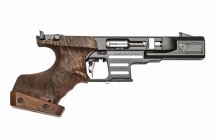I spent an hour talking to a "M41" gunsmith at Clark's Custom guns this year. This guy had smithed around 2000 M41's of all vintages. He had seen M41 slides that were curved due to the impact of thousands of rounds. As a rule, older M41's are softer, sometimes "a lot softer" than later ones. He recommended SV ammunition. I think his most common problem were rounds not feeding or ejecting due to out of square bolt faces and issues with extractor tension.
About late model M41's, the gunsmith said they are better machined and made out of better alloys than ever before. This does not mean they are more reliable or accurate, just that they are better built, and made out of better materials. The gunsmith had encountered late model M41's that had their own function issues.
When I asked about accuracy, I was glad to hear George and the Gunsmith both hesitating. Accuracy in a rimfire firearm ultimately depends on the ammunition. Lets assume the chambering job is right, the tube is good, ignition is positive, etc, then eventually the shooter will see lot to lot differences in accuracy. This is something that can be seen in rimfire rifles, I cannot hold that hard with a pistol to see lot to lot ammunition variations. Because I have had my Anschutz lot tested, I know for a fact that match ammunition varies between lots. And it is surprising how much it varies.
The Clark gunsmith said their M41's average 0.75 to 1.0 inch ten shot groups at 50 yards. Given the X ring is 1.3 inches, their M41's will meet their guarantee that the pistol will hold the X ring.
With a pistol, I am happy to break 800, I think my high is in the 830's. People who shoot 850's are God's in comparison to me. While I like my M46 and M41, I have had more stove pipes and squibs in the M41 than with my Ruger MKII's. And I think that is because the Ruger has a more robust ignition system. Weak ignition systems lead to weak ignition. Weak ignition will create a lot of stove pipes and failures to eject. When I come back from a match with a M41, I blow out the firing pin channel with compressed air. I found a firing pin swimming in the stuff, and oil in there acts as a damper, reducing the energy of the firing pin strike. I have replaced my M41 mainsprings and recoil springs. Always put new recoil springs in old M41's. Whether the new mainspring is a reliability improvement, I can't tell.
I do believe my M41 has a smoother recoil and less muzzle lift than my Rugers. I think that is due to the weight distribution of the M41 slide. Triggers tend to be outstanding. A M41 is simple to field strip, and I love that. I do think a M41 is an excellent competition pistol design.
Clark's Custom guns did a trigger job on a Ruger MKII of mine, and what a tremondous difference that made. Very little take up, crisp break, just a little over travel. It is hard to over emphasize the importance of a great trigger to good groups.
If the mechanical accuracy is the same between pistols, then what makes the difference is ergonomics. How does it fit your hands? Does pulling the trigger wave the pistol around? Things like that.
Many Bullseye shooters use a 22 lr frame that is identical to a 1911. That way, they don't have to relearn hand and finger position when going from the 22 lr and a 45 ACP. If you are going to shoot in an indoor 22lr match, a M41 is an excellent pistol to use. Finding one may be harder than wanting one.













